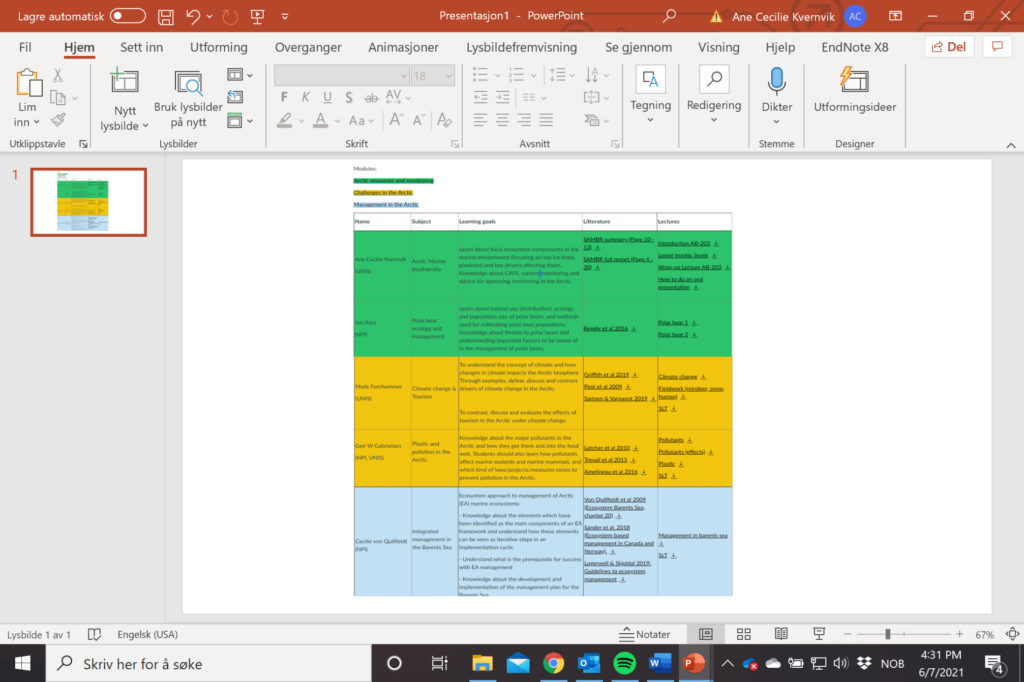Reflections on practice: How Corona and Canvas were helping tools in a course development
Lo and behold, this spring it finally happened: The students in the Arctic Environmental Management Course (AB-203) confirmed that the UNIS course had a “clear red line”.
 AB-203 used to have a lot of topics and many guest lecturers visiting UNIS, and as a result struggled to follow a red line. This year I was more or less forced to rethink the structure of the course, both due to Covid-19 (and the restriction of bringing guest lecturers to UNIS) and due to the use of Canvas (which famously divides a course in different modules). AB-203 have previously used modules to structure the different topics of the course. However each of these topics had different guest lecturers that could only come to UNIS at a certain time, which made it difficult to arrange the topics in a natural manner that was easy to follow. In addition, with so many guest lecturers you are bound to have some short term changes.
AB-203 used to have a lot of topics and many guest lecturers visiting UNIS, and as a result struggled to follow a red line. This year I was more or less forced to rethink the structure of the course, both due to Covid-19 (and the restriction of bringing guest lecturers to UNIS) and due to the use of Canvas (which famously divides a course in different modules). AB-203 have previously used modules to structure the different topics of the course. However each of these topics had different guest lecturers that could only come to UNIS at a certain time, which made it difficult to arrange the topics in a natural manner that was easy to follow. In addition, with so many guest lecturers you are bound to have some short term changes.
This year I started to think about all these topics. Are all of them really necessary? The academic content of AB-203 includes (1) the physical environment and ecosystems, including the geographical environment, ecosystems and natural resources, (2) challenges and conflicts, including climate, pollution, harvesting, cultural values and international relations and (3) institutions and legal framework, including law and conventions, international organizations and fields of responsibilities for institutions involved in the management of Arctic natural resources. Sound like a lot? There is really no end to how many topics you can include in such a course, so I decided to focus on some topics, and exclude some others. With Covid-19 and the restrictions that followed, I also had to prioritize which guest lecturers are strictly necessary at UNIS, and I landed on three guest lecturers that have extensive workshops, seminars and student led teaching. Some topics I decided to cover myself and the rest of the guest lecturers would have to deal with digital teaching this year. The result from this was that it was much easier to not only divide the different topics of AB-203 in modules, but also to cover them in succession: The first two weeks we covered all topics in “Arctic resources”, then we moved to “Challenges in the Arctic” before we in the end covered how these resources and challenges are managed (i.e. “Management in the Arctic”). By covering one module at a time it was also easier to wrap up every module e.g. by discussions, quizzes or tests, before we moved on to the next one.
 Canvas is also a terrific tool to help organize a course. The students in AB-203 were especially pleased with a curriculum table that I made. Here each module was color coded, and every topic arranged in the same succession as the lectures. In one table I summarized the lecturer, the learning goals, litterature and PDF of lectures.
Canvas is also a terrific tool to help organize a course. The students in AB-203 were especially pleased with a curriculum table that I made. Here each module was color coded, and every topic arranged in the same succession as the lectures. In one table I summarized the lecturer, the learning goals, litterature and PDF of lectures.
In summary, it was the reduction of topics (and guest lecturers) and digital teaching that worked wonders in AB-203, and I will not be so afraid to focus on fewer topics (but in more detail) next time.
By Ane Cecilie Kvernvik



